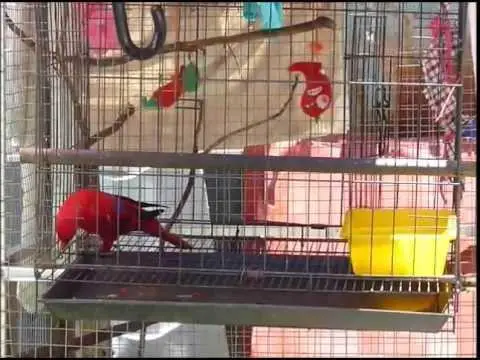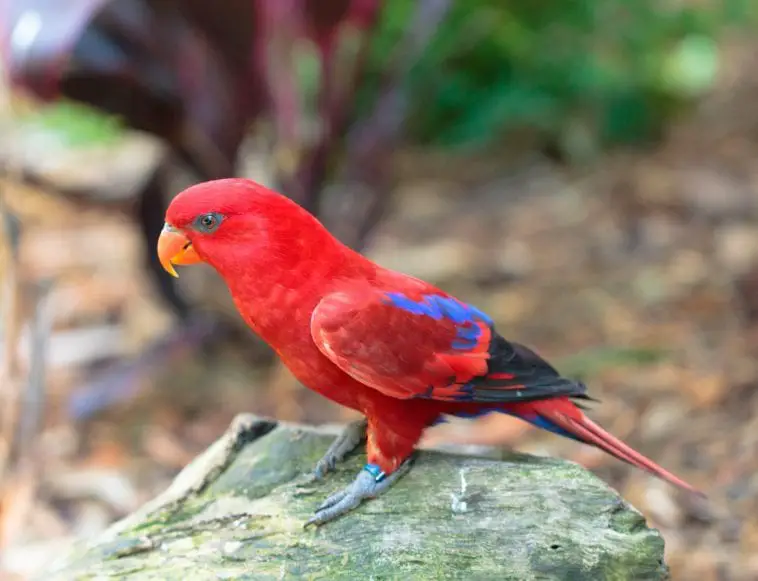Scientific Facts
| Common Name: | Red Lory |
| Scientific Name: | Eos bornea |
| Life Span: | 15 to 30 years |
| Size: | 10 to 12 inches |
| Habitat: | Tropical Mangrove and moist lowland forests |
| Country of Origin: | Indonesia |
Overview
In captivity, this is commonly kept as a pet. It is a favorite among the fancier and advanced novice because of its playful personality, intelligence, and beautiful appearance. It is an ideal pet for someone who has time and attention. The owner should be dutiful and attentive to the needs of this bird.
Here is a piece of short information about Red Lory:
- Their breeding age is 8 months.
- Their clutch size is 2 to 3 eggs.
- The egg incubation period is 24 days.
- Chicks are fledging after 40 to 50 days.
- Their IUCN Conservation Status listed it as “least concern.”
- Their Temperament as a pet is active.
- They need moderate maintenance.
- They have a high noise level.
- Their talking ability is good.
Physical Description
Seeing a small lory is like seeing a small parrot. Yes, they come from the parrot family. Their tongue structure is their most distinguishing characteristic. This tongue has long papillae and fuzzy appendages that are like a pom-pom. Their tongue is for pollen collecting. Another noticeable feature is its unique beak. Their upper mandible is narrower and has a tip that is more pointed than the other parrots.
Red lories are characterized by their deep pomegranate-red color with blue markings on their faces and wings. While their neck and head are of deep red color. They range in size from ten to twelve inches and have an orange beak.
The adult’s primary feathers are black widely covered in red, while the tertiary feather and covers are in blue. The feather’s joint is reddish-brown. In the eye, the iris is red, and the legs are grayscale.
Young red lories colors are more off that the coloring of their parents. The tertiary feathers are light blue and grey; ear-coverts have tinges of the blue, vent, and thighs have stains of blue, including the abdomen. Irises are brown. Males and females look the same, but males are just more corpulent than females.
Four Sub-species
a. Red Lories or the Eos bornea bornea. This is the nominated species.
b. Bernstein’s Red Lories, the Eos bornea bernsteini or Eos rubra bernsteini. It is distributed on the islands of Kai. It is on some parts of Maluku Island in Indonesia.
c. Buru Red Lories, the Eos bornea cyanonothus or Eos rubra cyanonothus. They are distributed in Buru, Maluku Province.
d. Rothschild’s Red Lories or the Eos bornea rothschildi, also known as Eos rubra rothschildi. It is found in Seram, Maluku Province.
Size and Weight
These birds grow from 10-12 inches and weigh 170 grams.
Native Region or Natural Habitat
They are endemic in Indonesia, and they are still there as a pet of the indigenous people. They inhabit the primary forest, wooded areas, deserted mangroves and gardens, coconut plantations, and forest hills.
They are mostly found in the coastal areas. In most areas in Indonesia, these bird populations are spread in the villages because they are so cautious to humans.
Lifespan
Red Lory’s can live up to 15 to 30 years when given enough care.
Behavior
Similar to other lories, red lories are active and intelligent too. They are really fond of toys, particularly rotating toys, but they tend to destroy their toys. Nonetheless, they are great pets, although they are nippy and temperamental sometimes.
They can be so loud, but in the morning or evening, before you turn out the lights, they scream rarely. At noon, they spend time to smooth their feather under a tree shade. This could be a way to make their marital ties stronger. They really can be too loud, but they amaze themselves with their soft trills, mutterings, and whistles. They are good talkers and make a complete sentence with their vocabulary. They also mimic sirens, telephone rings, and more. They mimic sounds precisely. They can be entertaining when they hop and hang themselves upside down.
Red lories live in small groups or in pairs, but they fly in flock having 50 of them. They fly above canopies. Red flowers of the coral tree attract them. They flap their wings quickly as they are fast and have a direct flight. On the Kai islands, they cross the sea arms at high altitude in fast flight.
Feeding
In captivity, red lories are fed on nectar-based and specific fruits. They crack seeds but should be given in moderation. An ideal diet is a pelleted diet with veggies and fruits as supplements. You can give chopped green or leafy veggies and fresh fruits. They love pasta and potatoes. Don’t give lettuce, tomato, and cabbage for these causes diarrhea.
Caffeine in chocolate and soda, as well as the fruit avocado, can be poisonous to them. Food having high iron content must not be given too. Mealworms from pet shops are acceptable too. In the wild, they eat pollen, fruits, nectar, and insects. Their special brushed tongue collects pollen. In other words, these lories have an important role in tree and flower pollination.
Speech & Sound
Red lories are chatty, making noise and throwing toys. Yes, they are great talkers but produces sound in high pitch and shrill cries.
Breeding and Reproduction
Red lories have no problem when getting along with other species, but they are strict in their territory and get jealous. A pair defends their territory and could kill others in their cage. Therefore, they should be isolated from other species.
For the nest box, it can be a natural log or a box-type man-made. Hang it horizontally or vertically. The hole should not go over than 2 inches, and don’t forget an inspection door.
Their will 5 eggs in a clutch. The mother bird incubates it. Eggs are hatched after 21 days. Males don’t do the incubating, but they stay in the nest to share in the chick feeding. Males are more vocal and so possessive to his partner, nest, and his aviary.
When the eggs are hatched, the chicks will be covered in white down on their upper body parts but are covered sparsely on the other parts. Bills are dark brown and have an egg tooth. After 5 weeks, chicks fledge, yet they stay with their mother and father for more months.
In Captivity
Red lories are so popular for their beauty, intelligence, and being entertaining. They are bred easily and available. They live for almost 28 weeks. After 8 months or more, they become sexually mature. Again, they have no sexual dimorphism. Only the use of DNA tests can determine their sex.
Behaviorally, they are curious, affectionate, and extrovert. When they sleep, they tend to wrap blankets on them. They get aggressive and territorial. They need attention and care. Giving a daily bath or shower is needed for their grooming. These birds are trainable and can be so intelligent with proper training and know-how.
Pet Quality
These lories are so loved and favorites among the lories. Their color and behavior make them stand out.
They will get you amazed with their talking and skill. They are tamed even when they are mature. Finding them is so easy for they are hand-reared pets and prolific breeders. At times, they can be annoying for being loud and having a high-pitched screech.
Housing

Unlike other parrots, lories feces are more liquid. they are messy for their feces are released in a projectile manner. It is not appropriate to put them inside the house. Putting them outside is ideal.
Their cage, that width is more important. They should be able to spread their wings inside and spacious rooms for their toys. Then, the cage should be 18’ by 18’ by 22’ at least. Make sure the cage is easily cleaned. Hosing it down is the best.
To match their intelligence, they need a stimulating type of environment. It is achieved by putting various toys. They enjoy their toys. Simple toys like empty toilet paper and a paper bag would be enough. Bells, blocks, and swings would be great too. Choose toys that are for small parrots.
For their nest, a commercial nest box is okay. A plastic bottle that is clean and quart-sized is a suitable nest. Just cut the opening to make a large entrance. The use of perches is also important. It suits the bird’s feet. Perches will exercise their feet and prevent the droppings from contaminating water and food. a mineral block or cuttlebone should be always available for calcium supply and prevent overgrowth of the beak.
Health & Common Conditions
Since lories eat nectar and fruit, which are highly perishable, infections caused by bacteria on spoiled food is a concern. Therefore, their liquid food must be replenished and changed as often as possible, especially in hot weather. A left fruit in the cage can be spoiled. Then, don’t leftover food in the cage.
Below are other disorders and diseases in which lories or other birds are susceptible to.
- Gout
- Liver disease
- Hemochromatosis. This is known as iron-storage disease. it is a metabolic disorder that causes an enormous amount of iron accumulated in the blood tissue of lory. It is fatal as it causes the death of lory. This disease can be hereditary, or diet caused.
- Psittacine beak and feather. Birds could be infected for some months before they develop abnormalities in their feathers.
What to Watch for
- Loose feathers- There is an appearance of abnormal and loose formed feathers. For a 2month old bird, the whole feather could be affected, whereas the adult can have the disease for a longer time.
- Beak lesions- This could come with ulcers and plaques in the bird’s mouth, and the beak can have a fracture.
- Systemic infection- This infection comes with the onset of depression, regurgitation, loss of appetite, diarrhea, crop stasis, and pneumonia.
- Dark patches the shaft of the feather- Some young birds experience depression and the appearance of patches in dark red-brown in their shaft.
- Chronic Problems- The birds who survive this disease develop a more chronic problem. Loss of feathers happens on each side of their body. The normal feathers are replaced with abnormal ones. After the malformed feathers, some die, while others live for some years but not having feathers.
- Incubation Period- The incubation period is from 21 to 24 days as the minimum while it would be 32 to 80 days for the chicks.
- Diagnosis- You should start suspecting when your bird has developing feather loss and malformed feathers. Take your pet to the vet.
- Treatment- Sadly, there isn’t any effective therapy for this virus, but when given supportive care, they can survive for some years. However, they should be isolated to avoid transmission.
- Vaccination- There was a vaccine developed. It was effective to prevent the disease, but this virus has developed resiliency making the vaccine too dangerous for the birds.
- Avian Chlamydiosis. This disease is due to a bacterium, which is Chlamydia psittaci. This disease is common in birds in cage and aviary, especially parrots. It is spread through inhaling dust, having dried saliva, droppings, mucus from the infected birds. Having direct contact with bird dropping, mucus, feathers, litters, and food and water that are contaminated spreads the disease.
Signs of AC:
Signs show differently on various bird species. They may not look sick and carries it for a long time. if they are sick, the signs are:
- difficulty in moving or flying
- cough
- death
- mucous or pus that comes out from the nostrils and eyes
- diarrhea or dark green droppings
- poor feeding
- Stress
Diagnosis and Treatment
There are tests to confirm this infection, but it has to be discussed with the vet. The test can be given either alive or dead status. Infected ones should be separated and take antibiotics, and the cages should be disinfected. The treatment does not guarantee a hundred percent effectivity, so this infection can come back.
Prevention
In order for this infection not to spread, the owner or caretakers should take these precautionary measures.
- Educate the persons at risk.
- Everyone who has contact with the infected bird should know the health risks.
- Caretakers should see a doctor.
- Check for the bird symptoms.
- Don’t buy sick birds.
- Keep a record of your bird transactions to know the sources of the sick birds and people who were in contact.
- Quarantine your new birds for thirty days.
- Do clean husbandry.
- Keep the cages away from one another.
- Give enough light and ventilation.
- Use newspaper to avoid dust production.
- Clean everything in the cage. Scrub everything well with soap.
- Always use a disinfectant solution.
- Isolate the sick birds.
- How to Protect yourself
- Right before and after you hold the bird, wash your hand using soap in running water.
- Use gloves or anything to protect you from the dust.
- Don’t get so close with the sick bird.
- Wet the litter before you clean to lessen the risk.
- Use disinfectants in an open area so as not to cause irritation on the human and bird’s lungs.
How to Care:
In order to fully grow your Red lory, there are things an owner must consider. Here are they:
- Housing. The cage must be spacious having 36″x 48″x 24″. Plus, toys and perches. Construct with spacious room for the bird’s movement, flying, and playing.
- Temperature. Keep the temperature at 70 or 80 F.
- Temperament & personality. Red lory can play the entire day but tends to get bored easily when playing the same toy for a long time. this bird hangs itself upside down.
- Feeding. Give commercialized nectar and fruits. Mealworms can be given for occasional treats. Change the food and water frequently.
- Care. Give attention and time. interaction and association are necessary.
Availability: Where to Get One?
Red lories are available in the pet stores, or avian-specialty stores and the bird breeders as well. In addition, you can adopt from avian-rescue organizations.
Fun Facts about Parrots
Parrots are known to be smart and have unique traits. Below are some of them. You will be amazed at how lovely and excellent these parrots are.
- Some of them grind their own calcium supplements. They turn the cockle shells to powder using pebbles or date pits. The male eats the powder, then offers it to the female before they mate.
- Their toes are zygodactyl. Their toes are configured. There are 2 in front and 2 behind.
- They want muttons too. Some of them eat meat too apart from their usual diet, which includes seeds, fruits, and nectars.
- Not all of them are tropical. Some parrot species live in the alpine.
- A part of their population is under extinction. Habitat destruction and poaching are some causes seen to decrease their population.
- They usually match their mate. They look identical virtually.
- They taste using the top of their beaks. Their taste buds at their mouth’s roof.
- A full-grown parrot can be as heavy as a cat.
- Some parrots’ species can live up to 80 years. Larger parrots live longer.
- Their feathers can have pigments of antibacterial. Their colorful plumage somehow protects them from damage or degradation.
- Some species migrate.
- The smartest parrot knew over 1,700 words. Puck, a parakeet, holds the 1995 Guinness book of world records.
How to Train Your Bird to Talk:
Preparing to Train Your Bird. Know your bird. Find out more about it.
- Build a relationship with him/her. Trust is very important for it to be accustomed to you. Spend a lot of time.
- Play with him or her often.
- Plan a routine. There should be training sessions regularly. The session can be for five minutes. Do it twice or five times a day.
Training Your Bird
- Start with basic words like hello, night, bye, and bird’s name
- Come up with behavior that would make your talk. Imitating sounds or tones or word parts.
- Go near your bird when you teach. This will make your bird focus on you.
- Include your friend or relative.
- Teach words repeatedly.
- Make the lesson fun. Give rewards when needed. Teach various sounds.
- Play a record of words. Do it for 5 minutes. Don’t do it longer than 5 minutes. It will strain your bird.
- You should be patient. Learning pace varies just how humans do.
FAQ Section
Can Lory birds talk?
They can be trained to talk with a good set of vocabulary. The smartest one knew about 1700 words and held a record in the Guinness Book of World Records.
How long do lory parrots live?
A lory can live as long as 20 to 30 years.
Do parrots live for 80 years?
Yes, they can. A small cockatoo can live for 20 years. Large birds live for 60 years or over. An African grey parrot is 50 to 60 years. The oldest one lived for over 80 years.
Why do parrots live so long?
In captivity, they live longer because they don’t have an encounter with their predators, unlike those parrots in the wild.
Do parrots mimic?
Yes, they do. Although they are not equally vocal, they imitate it for some reason. They learn their own calls from humans. They sing in lower notes. They reproduce human voices.
Can parrots mimic humans?
Parrots and songbirds learn to imitate human speech. Owners can teach their pets. When in the wild, they copy new sounds.
How do parrots see humans?
Yes, they do. They have a bigger vision of 300 degrees.
Why parrots can talk like humans?
According to a study, parrots learn a language similar to how humans learn. A flock of a parrot was found to make conversations.
How do Parrots see colors?
Parrots see all the colors similar to how a human sees. They see a wider vividness and starker differentiation of colors. In the ultraviolet spectrum, they can see. An ability that humans cannot do.
Can parrots actually speak?
Possibly. They can attune to the context of their environment and make word associations with words.



